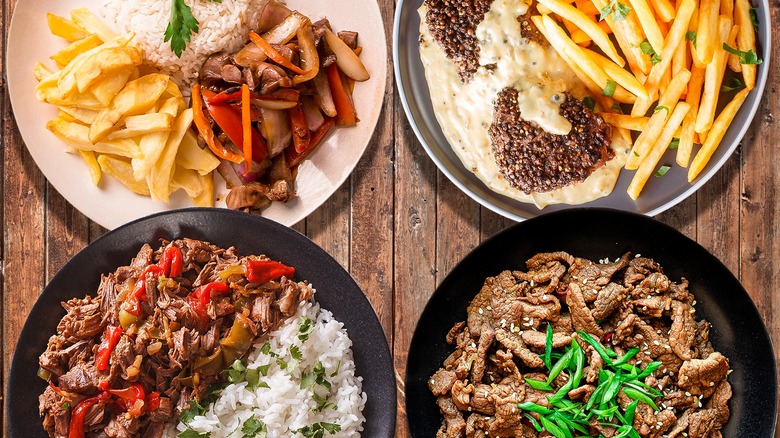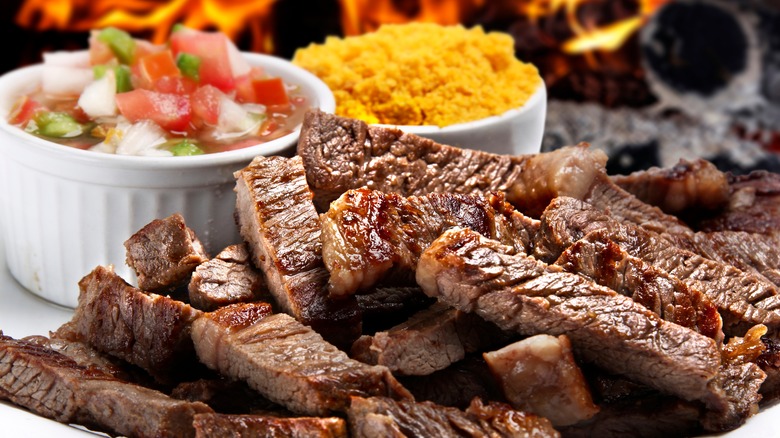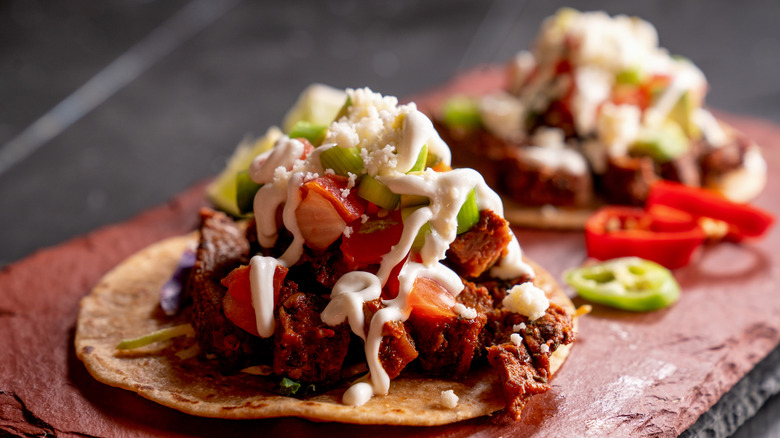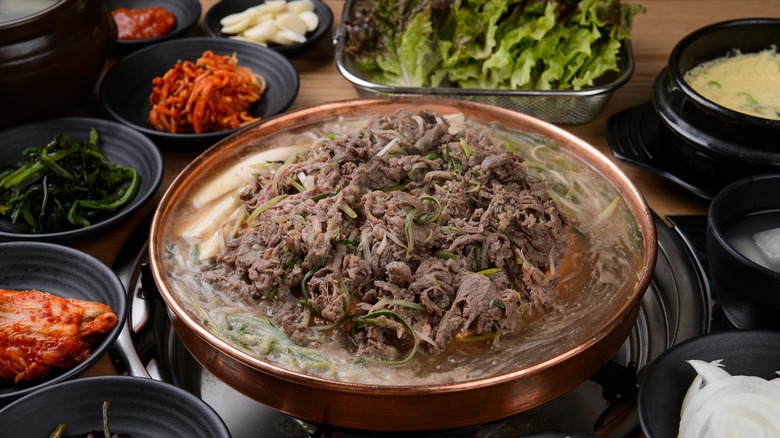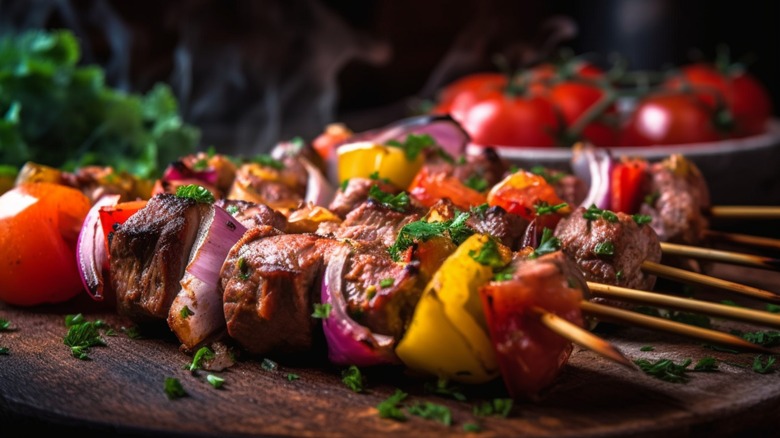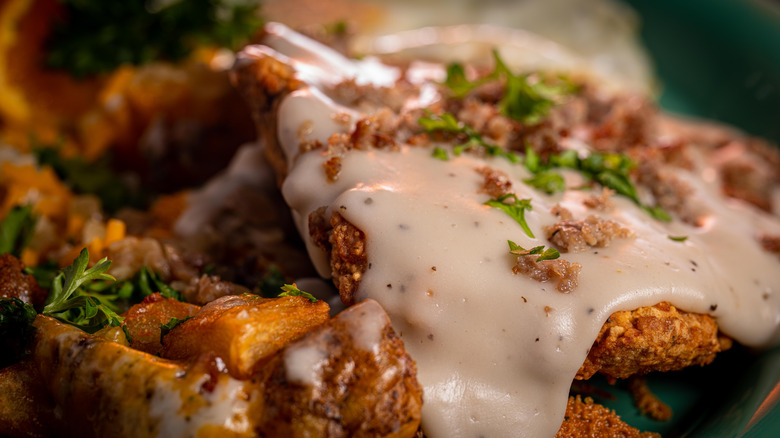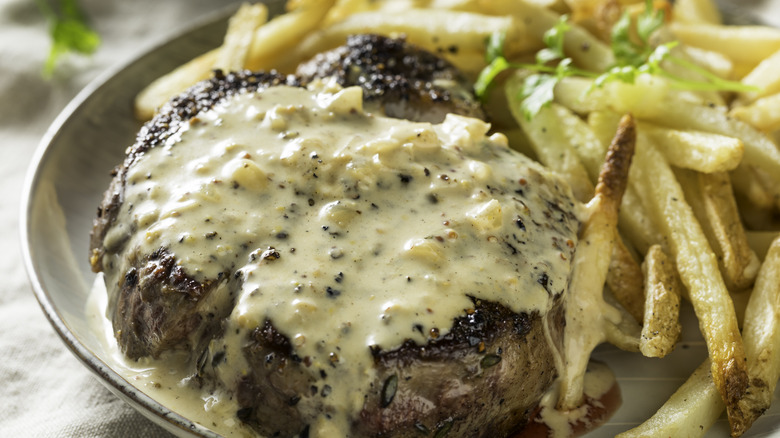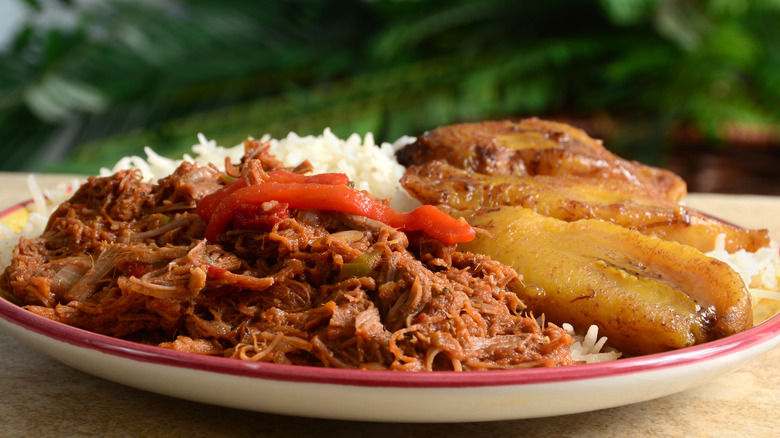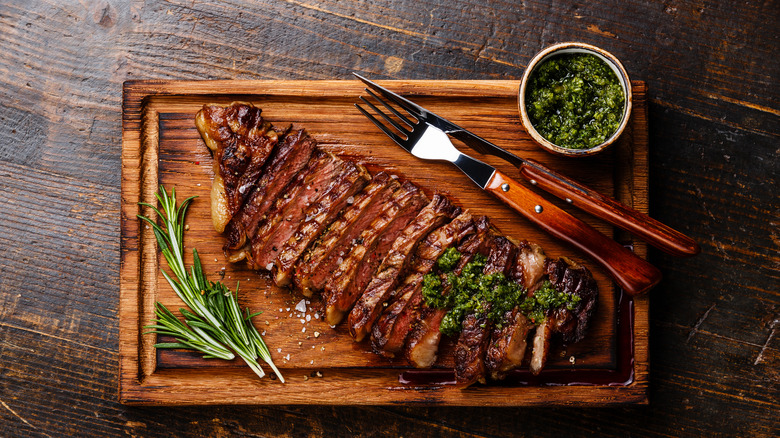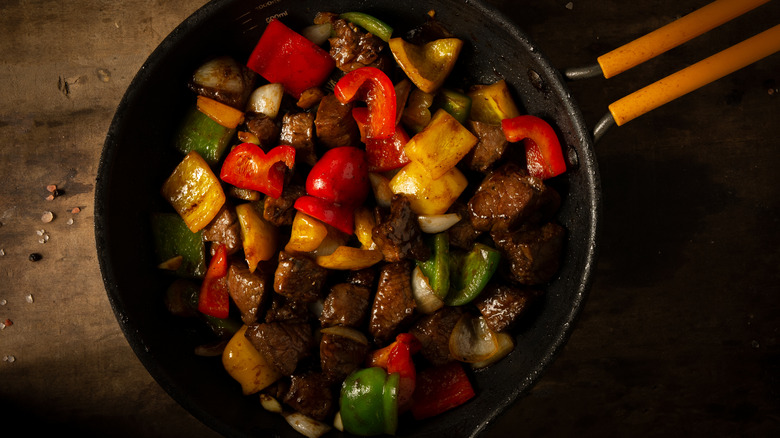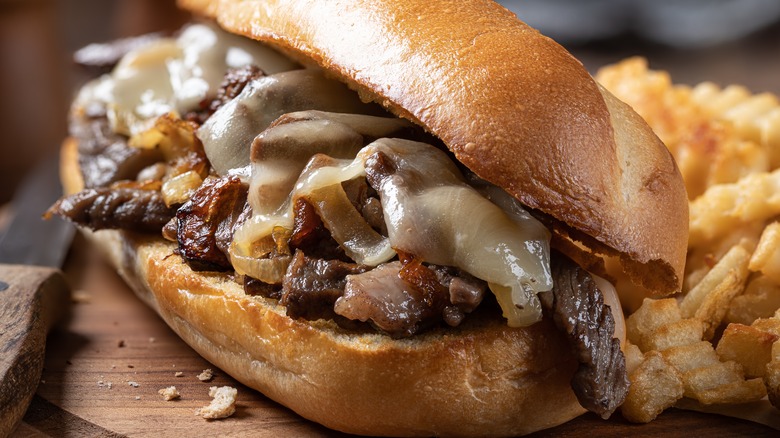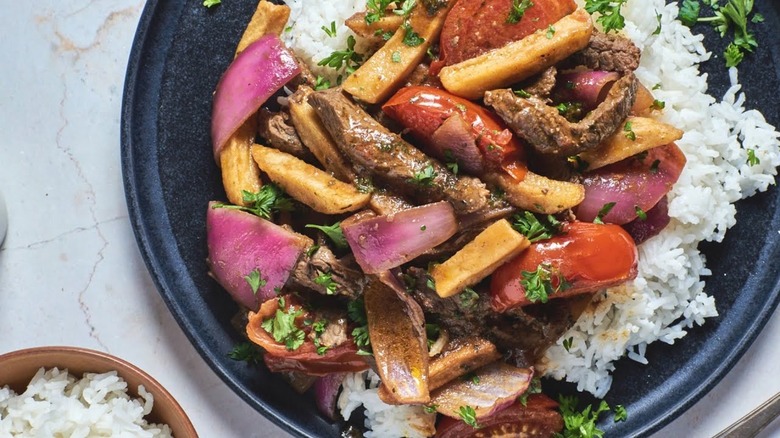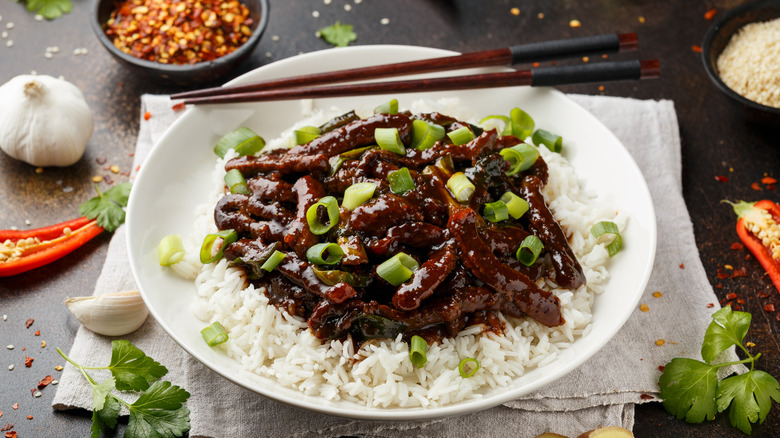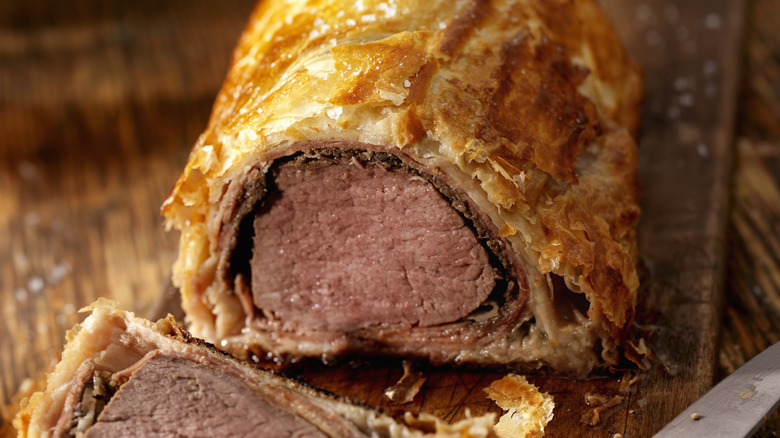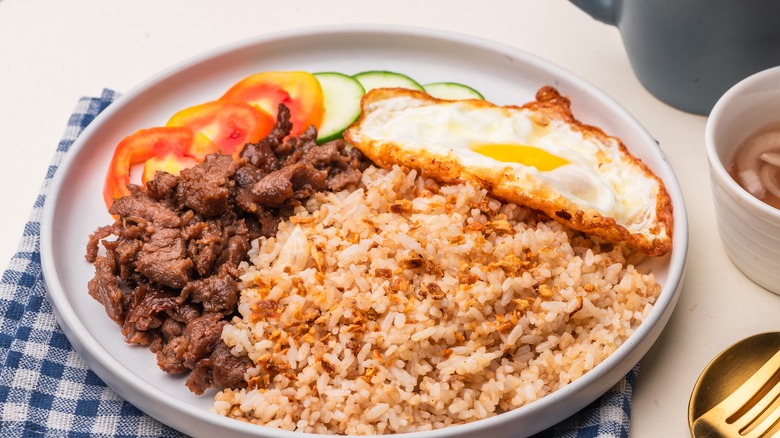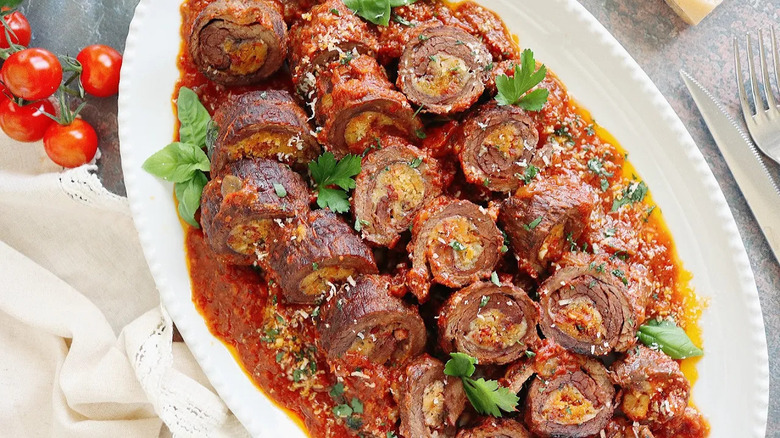15 Types Of Steak Dishes From Around The World
It doesn't get much better than a meal starring steak. Regardless of the cut of steak, and whether it's an elevated dish at a steakhouse, or a more economical dish made at home, in cultures across the world, steak is almost universally a favorite.
It's important to note that although the term "steak" typically conjures up images of beef, the word technically refers to a cut of meat sliced from a muscle of any animal. The term "steak" actually traces back to 15th century Scandinavia, where it was first used to refer to a thick cut of meat.
Today's modern interpretation of steak likely stemmed from 15th century Italy amid the Renaissance, when cultural celebrations in Florence employed large bonfires to cook meat. By the 1800s, beef had taken hold in the Americas; the rest is history. This list includes some of our favorite beef steak recipes from around the world, in no particular order.
1. Churrasco de picanha (Brazil)
Brazil is one of the places most notorious for its barbecue, and at the heart of its offerings is churrasco de picanha. A tradition that blossomed in the 16th century in southern Brazil, Brazil's method of barbecuing, known as "churrasco," involves grilling skewered meat over a fire. This is often accompanied by a specific style of service, known as "rodízio" style, meaning "rotation" or "turn" in Portuguese, which, according to legend, developed accidentally at a restaurant when a waiter took a meat skewer to the wrong table. This service is still typically seen at Brazilian steakhouses today and is associated with famous all-you-can-eat establishments in which you continuously sample a number of different cuts and styles of meat.
Picanha, meanwhile, refers to the cut of steak. Known as a rump cap or sirloin cap, picanha has a layer of fat that adds depth of flavor, leaving you with a cut of meat that's juicy, tender, and buttery. Traditionally, it is just seasoned with rock salt, allowing the meat's natural flavors to shine through. It's typically grilled alongside other Brazilian barbecue favorites like sausage and queijo coalho, a firm cheese, and served with sides like rice, beans, and farofa, a toasted cassava flour commonly enjoyed in Brazil.
2. Carne asada (Mexico)
Carne asada has become a quintessential part of Mexican cuisine, utilizing quick-cooking cuts of steak like flank or skirt, and then grilling it to both soften the meat and give it a delectable charred flavor. Marinating the steak ahead of time will ensure maximum flavor and tenderness, leaving you with carne asada that's smoky, slightly spicy, and full of depth.
This iconic steak dish traces back to the 16th century in Northern Mexico when Spanish colonizers brought cattle to the Americas. As the cattle industry flourished, so did enjoying carne asada. Nowadays, lauded both for its versatility, deliciousness, and ease of preparation, carne asada is typically enjoyed over tacos with cilantro, onion, spicy salsa, and a squeeze of lime or stuffed in burritos with cheese, rice, and beans. It is also considered to be a social food that is a staple of large celebrations.
3. Bulgogi (Korea)
This Korean barbecue dish, which translates to "fire meat," in reference to its original method of cooking using skewers and a grill, utilizes thinly cut pieces of meat, typically sirloin or rib eye, for a quick-cooking and gratifying flavor combination of sweet and salty. Bulgogi has become a cornerstone of Korean cuisine, with a deeply rooted history dating all the way back to the Goguryeo era (37 B.C. to 668 A.D.). By the 1920s, beef became more commonplace in Korea, and by the 1990s, bulgogi reached new heights of popularity, which has remained to this day.
Although bulgogi has become a staple at nearly every Korean restaurant in America, this Korean BBQ beef dish can still be replicated at home by coating your meat in a sweet and salty marinade and quickly grilling. Be sure to serve your steak with steamed white rice and kimchi for the full experience.
4. Shish kebab (Turkey)
This grilled, skewered steak dish has its roots in Turkey, but is popular across the Middle East, with mouth-watering variations across the world. One notable rendition are doner kebabs, which while also delicious and popular, are cooked on a vertical spit rather than being skewered and grilled over charcoal like shish kebabs.
The history of shish kebabs traces back centuries, with evidence of skewered meat in Turkey as early as the 9th century B.C. For the ultimate shish kabob, the meat is typically marinated in olive oil, lemon juice, and a range of spices and skewered along with vegetables like eggplant, onion, and tomato.
This dish lends itself well to customization, as you can easily utilize any vegetables you have on hand that can be skewered and grilled, as well as any number of cuts of steak or even other types of meat. The end result is appetizing, garlicky, and satisfying, especially when served with Turkish hayadari, a herby yogurt-feta sauce, and white rice on the side.
5. Chicken fried steak (USA)
This Southern steak dish is a twist on classic fried chicken. Although it uses beef instead of chicken, you're left with a chicken fried steak dish that's just as crispy and comforting. While the exact origins of this American classic are hard to trace, it became popular in the 1800s in states like Louisiana, Texas, and Oklahoma, where beef was produced. Some even say this dish's inception was influenced by German and Austrian immigrants, whose wiener schnitzel resembles chicken fried steak.
The use of cubed steak, which are tenderized pieces of thin steak that are also notably inexpensive, makes this meal accessible, while also allowing for creativity with the use of seasonings and spices. Whether you serve it for breakfast with eggs and hash browns, or with veggies for dinner, a dollop of creamy country gravy is non-negotiable when it comes to diner-style chicken fried steak.
6. Steak au poivre (France)
This classic French steak dish is indulgent with a little bite. Crunchy peppercorns coat the marinated steak, while a rich cognac sauce adds creaminess and decadence. Legend has it that this recipe was concocted back in 19th century Normandy, when prominent figures visiting bistros late at night would order it for their female companions due to the peppercorn's supposed aphrodisiac qualities. Regardless, the peppercorn adds a delightful crust to the steak, along with a prime opportunity for customization if making steak au poivre at home, as you can easily swap traditional black peppercorns for your pepper of choice, depending on your flavor and spice preferences.
The absolute best cut of steak for this dish is filet mignon, both flavor-wise and due to the cooking technique required for this preparation. Serve it with french fries or mashed potatoes on the side for a flavor-packed yet elegant meal.
7. Ropa vieja (Cuba)
Despite technically originating over 500 years ago in Spain, ropa vieja has become Cuba's national dish, and for good reason. It's hearty and filling, and thanks to its use of simple ingredients, is easy to replicate at home in a slow cooker. Preparation is simple; flank steak or beef chuck are shredded and mixed with a smooth tomato sauce and various seasonings, along with onion and pepper. Ropa vieja is best served over rice, black beans, and plantains, and it's one of Cuba's best foods that you have to try at least once.
And if you were wondering about the name, which translates to "old clothes" in Spanish, the story goes like this: A man with not a penny to his name was supposedly forced to cook his clothing due to lack of food. As the man prayed, a miracle occurred — it transformed into the revered meat dish we know and love today.
8. Asado with chimichurri (Argentina)
Another country lauded for its barbecue and steak-heavy cuisine is Argentina, and the star of the show is arguably asado with chimichurri. Asado is meat cooked on a parrilla, or a grill, a technique that originated in the 18th century and is credited to Argentinian gauchos, or cowboys.
As time passed, asado became a cornerstone in Argentine culture and cuisine, as both the types of meats used and the parrilla itself evolved. Traditionally, Argentinian asado grilling differs from other styles both in its technique and its social aspect; preparing the meat is typically an event (often involving multiple types of meats) that joins families and friends together. Although making it at home may be on a smaller scale than a traditional Argentine barbecue, it will still be delicious. Paired with a garlicky, herby chimichurri sauce that offers freshness and balance to the smokiness of the steak, you have a bold, memorable dish that's both simple and immensely gratifying.
9. Shaking beef (Vietnam)
Vietnamese shaking beef came to be during French colonization; beforehand, cows had only been used for labor, not food, in Vietnam. While initially shaking beef was seen as more of a luxury food reserved for formal events, today it has become more common — there is also a similar version popular in Cambodia, revered for its peppery, citrusy, and aromatic flavors.
This Vietnamese stir fry is named for a key part of the cooking process — you have to shake the pan in order to get an even sear. The dish comes together quickly with flavorful marinated steak cubes, a savory umami sauce, and vegetables like watercress and tomatoes that offer contrast and brightness. When served over rice, you have a complete, healthy, and satisfying meal. You can either opt for a higher quality cut like tender ribeye or filet mignon cubes or a more economical option like flank or sirloin — you can't go wrong with a dish like this.
10. Philly cheesesteak (USA)
This hearty sandwich has become a favorite in the U.S. for a reason. Stuffed with thinly shaved ribeye steak, sautéed onions, and provolone or cheese whiz (traditional Philly cheesesteaks don't come with bell peppers, but they're a frequent addition) on a thick, crusty roll, and you have a simple sandwich with maximum flavor.
The humble Philly cheesesteak first burst on the scene back in 1930s Philadelphia, when, according to legend, Pat Olivieri, who operated a hot dog stand, created the now iconic steak dish on a whim. At the time, the sandwich just included chopped beef and onions, with cheese not becoming an essential part of the sandwich until the following decade. Luckily, you don't have to travel all the way to Philly for a high-quality cheesesteak, as you can easily whip up an equally satisfying sandwich at home. The beauty of using a thinly shaved steak is that it cooks quickly — a homemade Philly cheesesteak can come together in just 15 minutes.
11. Lomo saltado (Peru)
This popular Peruvian meal takes elements of Chinese cuisine and fuses it with Peruvian ingredients, resulting in a salty, savory, and satisfying steak dish. The stir fry dish came to be in the 19th century when Chinese indentured servants from the Cantonese region were brought to Peru after the abolition of slavery. A new culinary style known as "chifa," came to be, and lomo saltado has since become a beloved dish across Peru, perfectly exemplifying a fusion between the two cultures.
Tender lomo saltado is just bursting with a vibrant blend of flavors and textures, and luckily, this classic steak entree can easily be replicated at home with thin cuts of steak — sirloin, strip, tri-tip, or ribeye are all preferable. Aji amarillo paste, soy sauce, and vinegar come together for a bold steak marinade, which is then tossed with onions and peppers, and served with crispy french fries and over rice.
12. Mongolian beef (Taiwan)
This sweet and savory dish has become a staple at Chinese American restaurants, and for good reason. Its tangy sauce is flavorful and thick without veering into spicy territory, and the tender melt-in-your-mouth beef, usually flank steak, makes the dish extra hearty and comforting.
Despite its name, the truth of Mongolian beef is that it has no actual Mongolian origins. In fact, the recipe was first developed in a Taiwanese barbecue restaurant, with the name referencing the fact that it was a Mongolian barbecue establishment (also a Taiwanese creation). Since then, Mongolian beef has gained a reputation as the ultimate comfort food, and fortunately, it is also an easy recipe to replicate at home in a slow cooker for the times when cravings for takeout hit. When served alongside white rice or over glass noodles and garnished with green onions and sesame seeds, you'll have a restaurant-quality meal that's aromatic and full of flavor.
13. Beef Wellington (England)
This British dish is typically reserved for special occasions, but nothing is stopping you from enjoying it any time of year. A beef filet is wrapped in flakey puff pastry, making for a delicious meld of textures and flavors and a dish that feels light and rich. Like most iconic dishes worldwide, its origin stories diverge, but one popular theory points to the famous Duke of Wellington, who allegedly favored portable dishes that could be enjoyed while marching. Others say that the dish was created merely to honor the duke, while a third theory simply theorizes that the dish resembles a Wellington boot.
Regardless of its true history, the dish rose in popularity in the '50s and '60s after famous chef Julia Child included a French variety of the recipe in her cookbook and then later on her cooking show. Although this dish may look complicated to master, ingredients can easily be minimized and simplified for an easy beef wellington sure to impress your friends and family.
14. Tapsilog (Philippines)
Tapsilog is a beloved Filipino breakfast dish that stars crispy, fried steak, served alongside fried egg, garlicky rice, a vinegar sauce for dipping, and oftentimes tomato and pickled papaya as well. Using thinly sliced sirloin makes it easier to achieve a properly crisped steak when making this meal at home, and be sure to coarsely chop the garlic so that it doesn't burn — this will go into the sweet and salty marinade that makes this iconic meal really shine.
Despite today's popularity, the steak dish has only been around for a few decades — it was created in 1986 when Vivian Del Rosario opened a modest tapa store. The name "tapsilog" comes from the three central ingredients: In the Philippines, "tapa" typically refers to smoked beef, while "sinangag," is garlic rice, and "itlog" is egg. The dish quickly became a bestseller and then a cultural phenomenon. Other variations have since popped up with various other protein choices, such as sausage or Spam, but none as popular as tapsilog.
15. Spicy beef braciole (Italy)
This Southern Italian dish incorporates thinly sliced steak, like top round or flank steak, rolled into a stuffing of savory ingredients like bread crumbs, cheese, seasonings, and sometimes other cured meats like pancetta, before being braised in a rich tomato sauce. Although braciole's history dates back to Italy, this recipe was given new life in the 19th and 20th centuries by Italian immigrants in the United States, where meat was more affordable.
Today, due to its lengthy cooking time, spicy beef braciole is seen as a dish reserved for special occasions — for that reason, it's not often found in Italian restaurants. Spicy beef braciole is a slow-cooking dish that's well worth the wait due to its depth of flavor. After slowly braising the steak, you'll be left with a tender, melt-in-your-mouth steak dish that's robust, satisfying, and delicious when served either on its own or over pasta.
